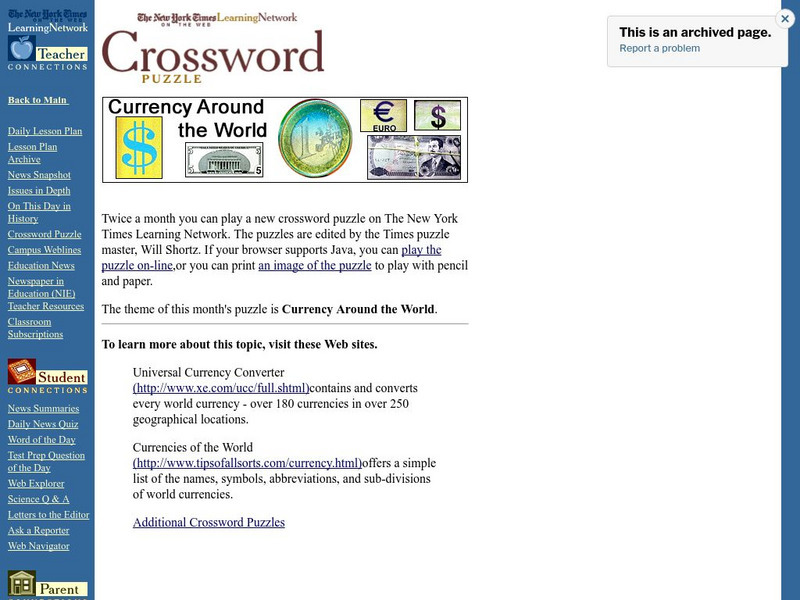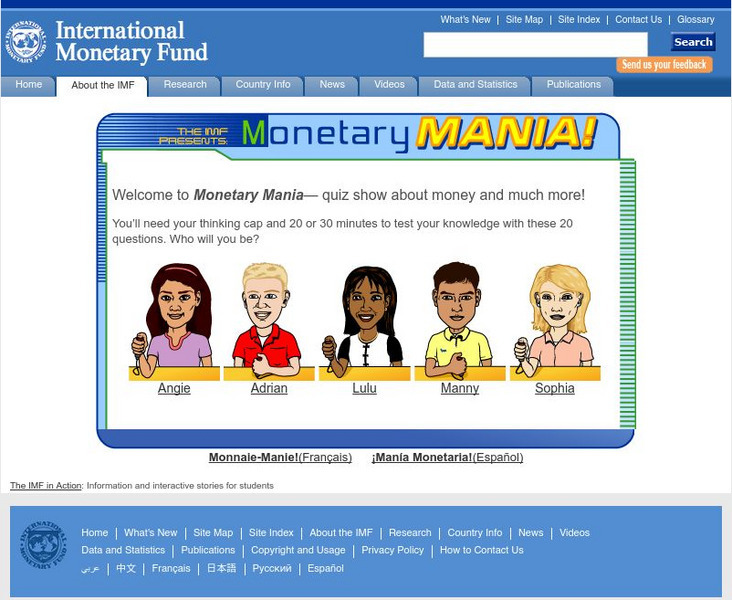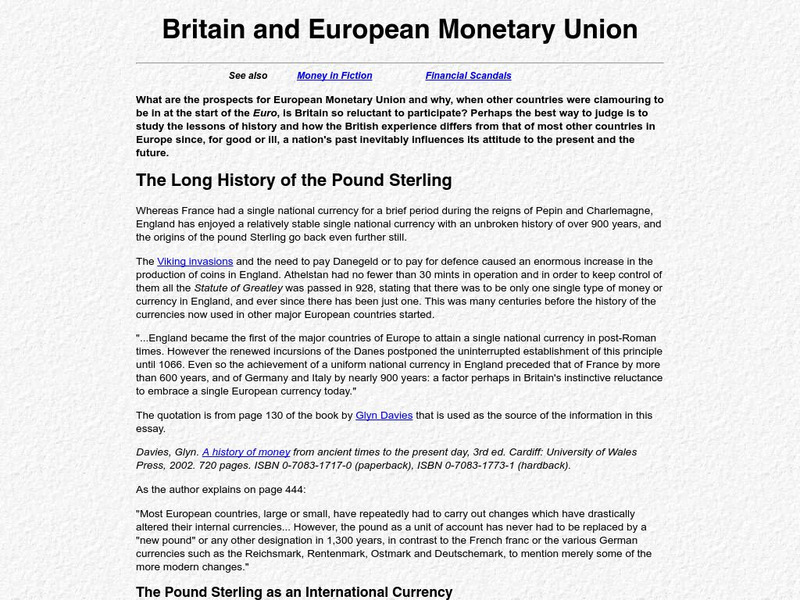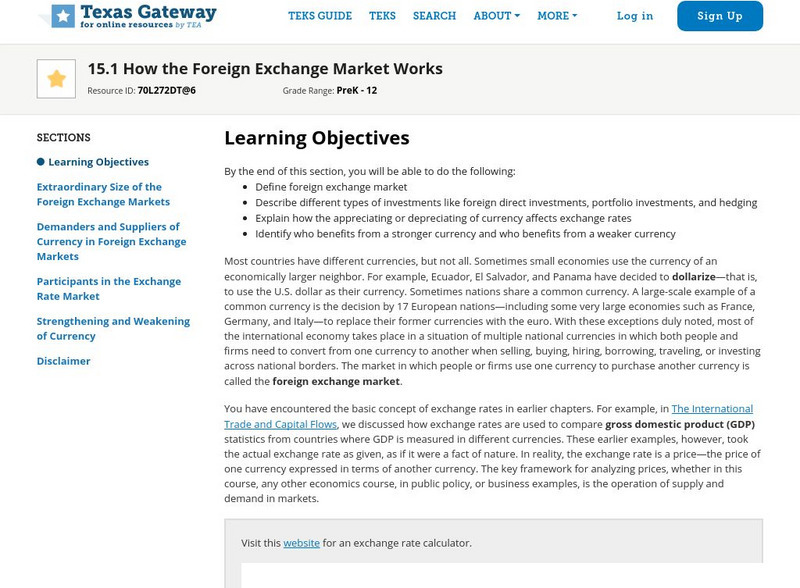Hi, what do you want to do?
Curated OER
Breaking News English: Kyoto Protocol Heated Bra Developed
For this English worksheet, students read "Kyoto Protocol Heated Bra Developed," and then respond to 47 fill in the blank, 7 short answer, 20 matching, and 8 true or false questions about the selection.
Georgia Department of Education
Ga Virtual Learning: Economics: International Economics: Trade and Currency
Economics learning module on international trade and currency. Unit includes multi-media resources, assignments, projects and tests.
Other
International Monetary Fund: All About Money [Pdf]
A valuable resource for educators who are teaching their students about money. A series of lesson plans cover everything from the different forms of currency over time, to trade and economic growth and exchange. Activities and games are...
Wisc-Online
Wisc Online: International Exchange Rates
This student-teacher resource discusses international exchange rate and shows how to calculate different currencies around the world.
Other
International Monetary Fund: Monetary Mania
All right, Angie. Now it's time to meet the other contestants. Nori is a typical high school student. She's always interested in learning more about money-especially how to earn it-but she hasn't taken any economics classes at school....
Econoclass
Econoclass: International Finance Classroom Simulation
In this classroom activity, students are divided into various groups, each being a different "country." Each country has their own currency and goods, and groups proceed to trade amongst themselves. This game covers the topics of...
Other
Financial Action Task Force on Money Laundering
The Financial Action Task Force (FATF) is an intergovernmental body whose purpose is the development and promotion of national and international policies to combat money laundering and terrorist financing.
Mount Holyoke College
International Relations: William Howard Taft: Dollar Diplomacy
President Taft's 1912 comments on his foreign policy that substituted "dollars for bullets."
New York Times
New York Times: Crossword Puzzle: Currency Around the World
An interactive & printable crossword puzzle developed by the New York Times Learning Network. The theme of this puzzle is Currency Around the World.
Other
International Monetary Fund: Monetary Mania
Great interactive online trivia quiz that lets you test your knowledge of macroeconomics against two other fictional players. Pick your player and go!
Council for Economic Education
Econ Ed Link: Exchange Rates and Exchange: How Money Affects Trade
Students learn how currency values are set by supply and demand, and how changes in the value of currency affect international trade. Students then find the value of the Brazilian Real in 2000 and 2002, determine whether the currency has...
Math Is Fun
Math Is Fun: Internal Rate of Return (Irr)
Explains, with examples, what an internal rate of return is, its uses, and how to calculate it using the net present value.
Other
University of Exeter: Britain and European Monetary Union
A discussion of the strength of the British pound sterling and why England has chosen not to join its European neighbors in the use of the Euro as a common currency. The author has a background in research and in the history of finance.
Texas Instruments
Texas Instruments: Net Present Value and Internal Rate of Return
In this activity, students deal with cash flow and its present value, which is its worth in today's dollars. They will compare alternative investments by determining their Net Present Value and Internal Rate of Return. They will also...
Khan Academy
Khan Academy: Using a Person's Budget to Understand the Balance of Payments
Just like a personal budget, the balance of payments uses the sources of funds and uses of funds to track the movement of money. In this article, we use a young wizard's budget to make the balance of payments more relatable. This...
Other
International Monetary Fund: Where & What in the World Is Money?
The International Monetary Fund (IMF) has created this interactive game that takes students on a time machine ride through history in order to learn about the different forms of money from the past.
Texas Education Agency
Texas Gateway: Ch. 15: How the Foreign Exchange Market Works
By the end of this section, you will be able to do the following: Define foreign exchange market; Describe different types of investments like foreign direct investments, portfolio investments, and hedging; Explain how the appreciating...
Other
Columbus: Empty Bowls
In this project, participants create ceramic bowls then serve a simple meal of soup and bread. Guests choose a bowl to use that day and to keep as a reminder that there are always "empty bowls" in the world. In exchange for a meal and...
Geographypods
Geographypods: Global Interactions: Economic Interactions and Flows
This learning module examines how money travels around the world between more developed and less developed nations, and the various forms it takes. Includes slideshows, student tasks, videos, maps, charts, and case studies, including one...
Other
United States Postal Service
As an independent agency of the government, the United States Postal Service homepage offers information on zip codes, address change, stamps, online billing, and variety of other topics.
Tramline
Virtual Field Trip: Windows on the World
At this site you will find interactive activities, maps, photos, and even audio and video clips for studying the cultures of the world.
The Federal Reserve System
Federal Reserve Board: The Fed Explained
This page provides access to "The Federal Reserve System/Purposes & Functions," a publication of the Board of Governors of the Federal Reserve System. This book is available as a complete publication or by chapter. The book covers...
Other
Money Management International: The Berenstain Bears' Trouble With Money
A lesson plan featuring the Berenstain Bears that introduces the concepts of spending, goods, services, income, saving, and interest.
Council for Economic Education
Econ Ed Link: Making Cents Out of Centimes: The Euro
Use this intermediate lesson to teach your students about the European currency, the Euro. Interactive links take the learner to France where they learn about French money and French culture.







![International Monetary Fund: All About Money [Pdf] Lesson Plan International Monetary Fund: All About Money [Pdf] Lesson Plan](https://static.lp.lexp.cloud/images/attachment_defaults/resource/large/FPO-knovation.png)
















